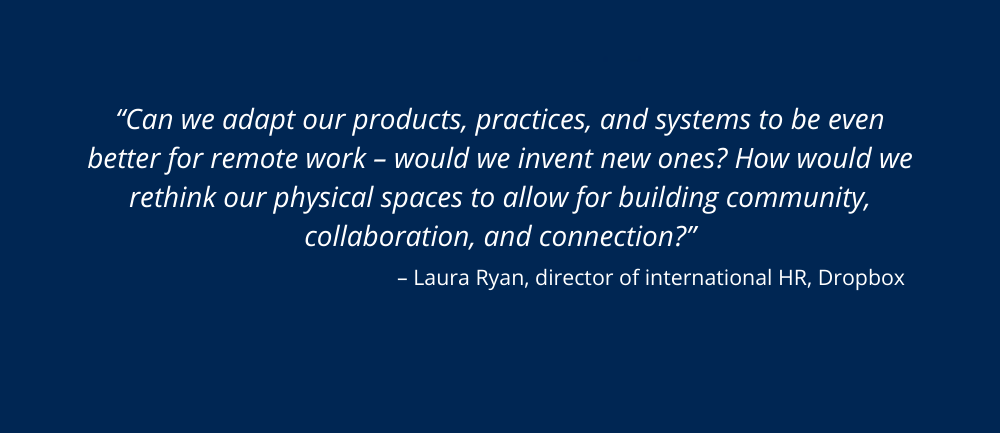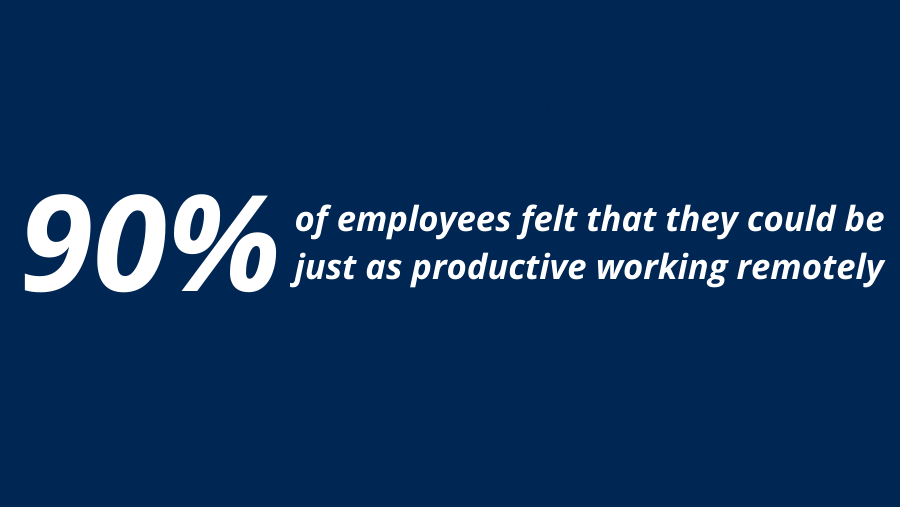-
Provided by

- Date published: May 6, 2021
- Categories
Like organisations across the world, Dropbox felt the seismic changes brought on by Covid-19, which included multiple national lockdowns. From one day to the next, everything the file hosting service did changed, and the future of work suddenly looked very different. The switch to remote work had its challenges, but was relatively manageable as the company used their own tools that enabled effective working from the get-go.
Six months down the line of working in this distributed model, Dropbox decided that they needed to put in place a strategy for the future. The goal was to ensure that their employees’ commitment and hard work, which had facilitated a smooth transition to remote work, was not left behind in the desire for a permanent strategy that addressed the challenges of the much-discussed “new normal”.
In this case study, Laura Ryan, director of international HR at Dropbox, outlines how the firm smoothly navigated to a virtual model, with a view to aiding employees and organisational performance.
Assessing the challenge
We feel the data shows the shift to remote work across society, although it was abrupt, has been successful for the majority. A study from The Economist Intelligence Unit commissioned by Dropbox found that knowledge workers are more focused at home and just as engaged as before. In our own internal surveys, most employees say they’re able to be just as productive at home (nearly 90%) and don’t want to return to a rigid five-day in-office work week and the challenges that would reimpose upon them.
We wanted to make sure our strategy moving forward encompassed this shift. When looking back it is clear to see the challenge was redesigning work life so that we could make sure that in-person collaboration and human connection were still at the centre of what we did, even as we opened up channels for increased flexibility.
When we set about designing our new policy we asked ourselves: If we had the opportunity to start again with a blank page, how would we redesign our work life?
The questions we considered including how would we give our teams the flexibility that remote work offers, but with the benefit of human connection and community that has been missing for many? Can we adapt our products, practices, and systems to be even better for remote work – would we invent new ones? How would we rethink our physical spaces to allow for building community, collaboration, and connection?
A new policy in practice
So, what has this meant in practice? Well, this change means that remote work is the primary experience for all our teams and the go-to default for individual work. Of course, there will always be occasions where it makes sense to come together physically in real life.

To overcome this, we are going to continue to invest in team collaboration and connectivity by offering physical spaces called Dropbox Studios, once restrictions allow in our respective geographies. These will be collaborative spaces designed for team gatherings instead of a collection of desks and individual workspaces that you go to every day. In fact we have intentionally designed our studios to have no individual workspaces so as to preserve the integrity and principles of our virtual first working model.
In line with this shift to improve flexibility, we’ve embraced what we call “non-linear workdays”, which offer employees in different geographies core collaboration hours, with overlap between time zones. This system is designed to encourage our staff to design their schedules around those hours and patterns that suit their needs best. As our workforce becomes more distributed, this will help allow our teams to be flexible by balancing collaboration with needs for individual focus. We want to prioritise impact and results instead of hours worked.
The final component of this new way of working has been redesigning the whole employee experience around Virtual First, from IT to HR. We continue to invest in the goal of creating a holistic ecosystem of resources, including a dedicated team to support employees and track our progress by measuring impacts on productivity, engagement, and culture. As a first step, we’ve developed a Virtual First Toolkit, which we’re also open-sourcing so that we can add to it and share our learnings as we go and help others to embrace new methods of working.
Engaging the board

For the board the decision was straightforward. They surveyed the key data and understood that our employees wanted their newfound flexibility to remain a constant part of their life at Dropbox. They agreed that staying true to our core principles, mission, and desire to change work for the better necessitated this shift to Virtual first. Our aim is to create a level playing field, fairness and equity for anybody who joins the company.
Measuring the outcome
Of course, changing to mandatory remote work has presented some challenges – as it has done for all businesses that have made that transition over the past 12 months. However, it is clear that our employees have appreciated the new flexibility that resulted from our new approach.
In our recent employee engagement survey we asked, “how productive are you working remotely?”, and the majority answered favourably (extremely productive/very productive); while fewer than 10% answered unfavourably (somewhat productive/not productive). A ringing endorsement for our new way of working.

We hope that adding more flexibility and freedom to the way we work – such as increased options around where you can live, and shorter, clearly defined core collaboration hours – will not just be attractive to employees old and new but will help us to retain talent by allowing them to tailor work to their rhythms and modes of working.
We accept that this has been a big change for many of our employees, so the holistic ecosystem we’re creating is there to support employees through the transition, to make sure they have what they need to succeed as we embark on this next part of the journey.
Ultimately, we believe that the move to Virtual First is the right decision for Dropbox for the long term, and will help us build an innovative, sustainable workplace for the future. We want to be home to the future of work and we believe this to be it.
Strategising for the future
We felt that the key takeaway for us was that big decisions cannot always have perfect timing. It took a global pandemic for many to realise that Virtual First working was possible, but this, of course, posed many hurdles in terms of implementation. Whilst the concept of remote working is not new, the difference is that social norms have now shifted to a more progressive manner given that many workers have been able to work remotely successfully for the past year.
One of the biggest challenges has been adjusting our working patterns as many of us were unable to fully experience the benefits of a Virtual First working model. We believe that the decision we have made will bear fruit over the coming months and that Dropboxers across the world will be able to reap the rewards of a new way of working.

In the end, we believe that Virtual First offers something new and exciting unlike the “hybrid-remote” models many companies are announcing, which is one where employees choose whether or not to work out of the office.
At Dropbox, creating an equitable employee experience regardless of role and location was of utmost importance. We believe that Virtual First offers something different from the “hybrid-remote” models many companies are announcing, which is one where employees choose whether or not to work out of the office.
Our Virtual First model allows a level playing field for all our employees which was a key factor in creating it in the first place. Hybrid models by their design will naturally perpetuate two very different employee experiences which we fear would result in problems of inclusion, or inequities concerning performance or career trajectory.

